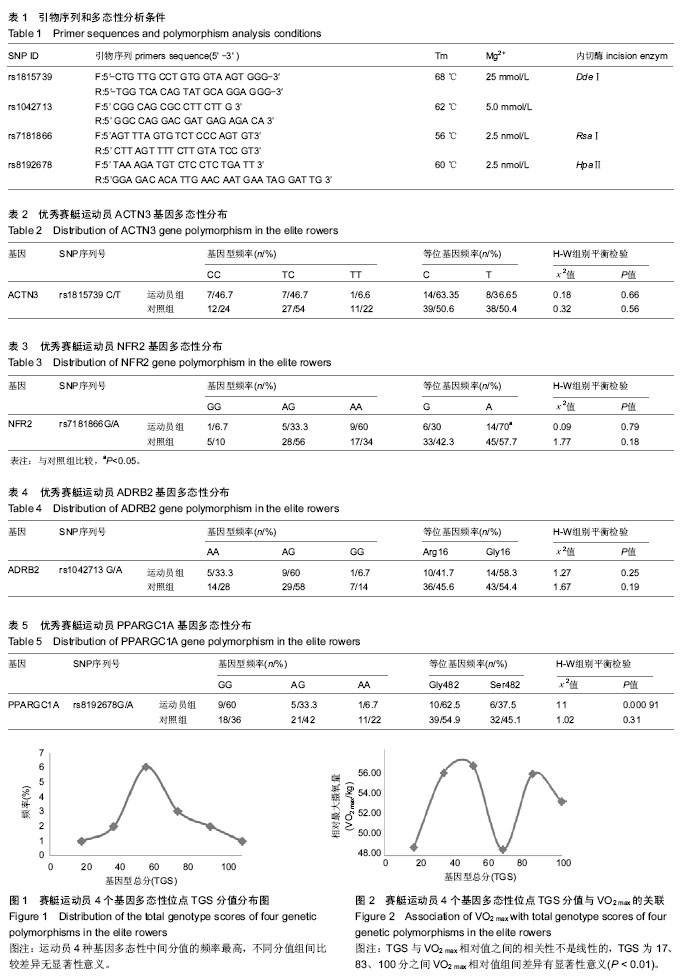| [1] De Moor MH, Spector TD, Cherkas LF,et al.Genomewide linkage scan for athlete status in 700 British femaleDZ twin pairs.Twin Res Hum Genet.2007;10:812-820.[2] Simoneau JA, Bouchard C.Genetic determinism offiber type proportion in human skeletal muscle.FASEB J.1995;9:1091-1095.[3] Alonso L,Souza E, Oliveira M, et al.: Heritability of aerobic power of individuals in northeast Brazil. Biol Sport .2014;31:267-270.[4] Ahmetov II,Kulemin NA,Popov DV.et al.Genome-wide association study identifies three novel genetic markers associated with elite endurance performance. Biol Sport.2015;32:3-9. [5] Ruiz JR,Arteta D,Buxens A,et al.Can we identify a poweroriented polygenic profile.JAppl Physiol. 2010;108:561-566.[6] Alun G. Williams, Jonathan P.Folland. Similarity of polygenic profiles limits the potential for elitehuman physical performance.J Physiol. 2008;586(1):113-121.[7] Wang G, Padmanabhan S, Wolfarth B,et al. Genomics ofelite sporting performance: what little we know andnecessary advances. Adv Genet. 2013;84: 123-149.[8] 何子红,胡扬,刘刚,等中国北方地区汉族男性PPARGC1基因多态性与耐力训练效果的关联性研究[J]中国运动医学杂志, 2006,25(2):156-160.[9] 杨晓琳,胡扬,李燕春,等.ACTN3基因C1747T多态位点作为举重运动员选材用分子标记的可行性研究[J]体育科学, 2010,30(1):70-73.[10] 罗齐军,刘紫荆,肖驰,等. ADRB2基因A46G多态性与运动耐力相关性分析[J]河北体育学院学报,2012,26(2):80-82.[11] Ahmetov II,EgorovaEmiliya S, GabdrakhmanovaLeysan J,et al. Genetics and Sports, ed 2, revised, extended.Med Sport Sci. Basel, Karger.2016;(61):41-54.[12] Rankinen T,Fuku N,Wolfarth B,et al.No Evidence of a Common DNA Variant Profile Specific to World Class Endurance Athletes. PLoS One. 2016;11(1):e0147330. [13] Bouchard C,Daw EW,Rice T, et al. Familial resemblance forVO2max in the sedentary state: the HERITAGE family study. Medicine and science in sports and exercise.1998;30(2):252-258. [14] Lortie G,Bouchard C,Leblanc C, et al.Familial similarity in aerobicpower. Hum Biol.1982; 54(4):801-812. [15] Bouchard C,Tremblay A,Despres JP,et al.The response to exercisewith constant energy intake in identical twins.Obes Res. 1994;2(5):400-410.[16] Hamel P, Simoneau JA, Lortie G, et al.Heredity and muscle adaptation to endurancetraining.Medicine and science in sports and exercise. 1986;18(6):690-696. [17] Prudhomme D,Bouchard C,Leblanc C,et al.Sensitivity of maximal aerobic power totraining is genotype-dependent. Medicine and science in sports and exercise. 1984;16(5):489-493.[18] Bouchard C, An P, Rice T, et al.Familial aggregation of VO(2max)response to exercise training: results from the HERITAGE Family Study. Journal of applied physiology(Bethesda, Md: 1985). 1999;87(3):1003-1008. [19] Skinner JS, Jaskolski A, Jaskolska A,et al.Age, sex, race, initial fitness,and response to training: the HERITAGE Family Study. Journal of applied physiology (Bethesda,Md:1985). 2001;90(5):1770-1776. [20] Yang N, MacArthur DG, Gulbin JP, et al.ACTN3 genotype is associated with human elite athletic performance.Am J Hum Genet. 2003;73(3): 627-631.[21] Moran CN, Yang N, Bailey ME, et al.Association analysis of the ACTN3 R577X polymorphism and complex quantitative body composition and performance phenotypes in adolescent Greeks.Eur J Hum Genet.2007;15(1):88-93.[22] Niemi AK, Majamaa K.Mitochondrial DNA and ACTN3 genotypes in Finnish elite endurance and sprint athletes.Eur J Hum Genet.2005; 13(8):965-969.[23] Lucia A, Gomez-Gallego F, Santiago C, et al.ACTN3 genotype in professional endurance cyclists.Int J Sports Med.2006;27(11):880-884.[24] Clarkson PM, Hoffman EP, Zambraski E,et al. ACTN3 and MLCK genotype associations with exertional muscle damage.J Appl Physiol. 2005;99(2):564-569.[25] Roth SM,Walsh S,Liu D,et al. The ACTN3 R577X nonsenseallele is under-represented in elite-level strength athletes.Eur J Hum Genet. 2008;16(3):391-394.[26] Clarkson PM, Devaney JM, Gordish-Dressman H, et al.ACTN3 genotype is associated with increases in muscle strength in response to resistance training in women.J Appl Physiol.2005; 99:154-163.[27] 杨贤罡,李燕春,胡扬. ACTN3基因R577X多态性与运动能力的关联性研究:Meta分析[J].体育科学,2011,31(3):44-52[28] Kelly DP, Scarpulla RC. Transcriptional regulatory circuits controlling mitochondrial biogenesis and function. Genes Dev.2004,18:357-368.[29] Scarpulla RC. Nuclear activators and coactivators in mammalian mitochondrial biogenesis.Biochim Biophys Acta 2002;1576:1-14.[30] Bouchard C, Rankinen T, Chagnon YC,et al. Genomic scan for maximal oxygen uptake and its response to training in the HERITAGE Family Study. J Appl Physiol.2000;88:551-559.[31] Ostrander EA, Huson HJ, Ostrander GK. Genetics of athletic performance.Annu Rev Genomics Hum Genet. 2009;10: 407-429.[32] 何子红,许志勇,陆霞,等.NRF2基因多态性与中国北方地区汉族男性有氧能力的关联[J].中国运动医学杂志,2007,26(2):139-144.[33] He Z, Hu Y, Feng L,et al.NRF2 genotype improves endurance capacity in response to training.Int J Sports Med. 2007;28:717-721.[34] Wolfarth B, Rivera MA, Oppert JM,et al.A polymorphism in the alpha2a-adrenoceptor gene and endurance athlete status.Med Sci Sports Exerc.2000;32:1709-1712.[35] Wolfarth B, Rankinen T,Muhlbauer S,et al.Association between a beta2-adrenergic receptor polymorphism and elite endurance performance. Metabolism.2007;56:1649-1651.[36] Wagoner LE ,Craft LL ,Singh B,et al.Polymorphisms of the beta2-adrenergic receptor determine exercise capacity in patients with heart failure.Circ Res.2000;86(8):834-840.[37] Ahmetov II, Mozhayskaya IA, FlavellDM,et al. PPAR-alpha genevariation and physical performance inRussian athletes.Eur J ApplPhysiol.2006;97:103-108.[38] Lucia A, Gómez-Gallego F, Barroso I, et al.PPARGC1A genotype (Gly482Ser) predicts exceptional endurancecapacity in European men. J Appl Physiol. 2005;99:344-348 .[39] Franks PW, BarrosoJ, Luan JA, et al.PGC1a Genotype modifies the association of volitional energy expenditure with VO2max .Med Sci Sports Everv.2003;35(12):1998-2004.[40] Mathai AS, Bonen A, Benton CR,et al.Rapid exercise-induced changes inPGC-1alpha mRNA and protein in human skeletal muscle. Journal of Applied Physiology. 2008;105:1098-1105.[41] Stumvoll M,Fritsche A,t' Hart LM,et al.The Gly482Servariant in the peroxisome proliferator -activated receptor gammacoactivator -1 is not associated with diabetes –relatedtraits in non -diabetic German and Dutch populations.Exp Clin Endocrinol Diabetes. 2004;112(5):253-257[42] 何子红,胡扬,刘刚.中国北方地区汉族男性PPARGC1基因多态性与耐力训练效果的关联性研究[J].中国运动医学杂志,2006,25(2):156-160[43] Eynon N, Hanson ED, Lucia A, et al.DoPPARGC1A and PPARa polymorphisms influence sprint orendurance phenotypes?Scand J Med Sci Sports.2010;20: e145-e150[44] Maciejewska A, Sawczuk M, Cieszczyk P, ThePPARGC1Agene Gly482Ser in Polish and Russian athletes,J Sports Sci. 2012;30(1): 101-113.[45] RankinenT,Wolfarth B, Simoneau JA, Maier-Lenz D,et al.No associationbetween the angiotensin-converting enzyme ID polymorphism and elite endurance athlete status. Journal of applied physiology (Bethesda,Md: 1985). 2000; 88(5):1571-1575. [46] Rivera MA, Dionne FT, Simoneau JA,et al. Muscle-specific creatinekinase gene polymorphism and VO2max in the HERITAGE Family Study. Medicine and science insports and exercise. 1997; 29(10):1311-1317. [47] Rivera MA, Perusse L, Gagnon J, et al.A mitochondrial DNA D-looppolymorphism and obesity in three cohorts of women. Int J ObesRelatMetabDisord.1999; 23(6):666-668. [48] Wolfarth B, Rankinen T, Muhlbauer S,et al.Endothelial nitric oxidesynthase gene polymorphism and elite endurance athlete status: the Genathlete study.Scand J Med Sci Sports. 2008;18(4):485-490.[49] Bray MS, Hagberg JM, Perusse L,et al.The human gene map forperformance and health-related fitness phenotypes: the 2006-2007 update. Med Sci Sports Exerc. 2009;41(1):35-73. [50] Mikami E, Fuku N, Takahashi H, et al. Polymorphisms in the controlregion of mitochondrial DNA associated with elite Japanese athlete status. Scand J Med Sci Sports.2013; 23(5):593-599. |
.jpg) 文题释义:
基因位点:基因在染色体上占有的特定位置叫基因位点。基因位数很多,而染色体的数目较少,因而一条染色体上含有许多基因。基因在染色体上呈单行直线排列。
α-辅肌动蛋白3基因:是存在于肌原纤维内的一种基因,其作用是合成α-辅肌动蛋白3,固定不同的肌动蛋白。运动员在运动训练中骨骼肌α-肌动蛋白的mRNA水平提高,另外在运动恢复过程中骨骼肌α-肌动蛋白基因的表达具有时效性。α-辅肌动蛋白3基因定位于人染色体11q13-q14。上下肢骨骼肌中有α-辅肌动蛋白3基因表达,但是在脑组织中表达量较低。
文题释义:
基因位点:基因在染色体上占有的特定位置叫基因位点。基因位数很多,而染色体的数目较少,因而一条染色体上含有许多基因。基因在染色体上呈单行直线排列。
α-辅肌动蛋白3基因:是存在于肌原纤维内的一种基因,其作用是合成α-辅肌动蛋白3,固定不同的肌动蛋白。运动员在运动训练中骨骼肌α-肌动蛋白的mRNA水平提高,另外在运动恢复过程中骨骼肌α-肌动蛋白基因的表达具有时效性。α-辅肌动蛋白3基因定位于人染色体11q13-q14。上下肢骨骼肌中有α-辅肌动蛋白3基因表达,但是在脑组织中表达量较低。.jpg) 文题释义:
基因位点:基因在染色体上占有的特定位置叫基因位点。基因位数很多,而染色体的数目较少,因而一条染色体上含有许多基因。基因在染色体上呈单行直线排列。
α-辅肌动蛋白3基因:是存在于肌原纤维内的一种基因,其作用是合成α-辅肌动蛋白3,固定不同的肌动蛋白。运动员在运动训练中骨骼肌α-肌动蛋白的mRNA水平提高,另外在运动恢复过程中骨骼肌α-肌动蛋白基因的表达具有时效性。α-辅肌动蛋白3基因定位于人染色体11q13-q14。上下肢骨骼肌中有α-辅肌动蛋白3基因表达,但是在脑组织中表达量较低。
文题释义:
基因位点:基因在染色体上占有的特定位置叫基因位点。基因位数很多,而染色体的数目较少,因而一条染色体上含有许多基因。基因在染色体上呈单行直线排列。
α-辅肌动蛋白3基因:是存在于肌原纤维内的一种基因,其作用是合成α-辅肌动蛋白3,固定不同的肌动蛋白。运动员在运动训练中骨骼肌α-肌动蛋白的mRNA水平提高,另外在运动恢复过程中骨骼肌α-肌动蛋白基因的表达具有时效性。α-辅肌动蛋白3基因定位于人染色体11q13-q14。上下肢骨骼肌中有α-辅肌动蛋白3基因表达,但是在脑组织中表达量较低。
.jpg) 文题释义:
基因位点:基因在染色体上占有的特定位置叫基因位点。基因位数很多,而染色体的数目较少,因而一条染色体上含有许多基因。基因在染色体上呈单行直线排列。
α-辅肌动蛋白3基因:是存在于肌原纤维内的一种基因,其作用是合成α-辅肌动蛋白3,固定不同的肌动蛋白。运动员在运动训练中骨骼肌α-肌动蛋白的mRNA水平提高,另外在运动恢复过程中骨骼肌α-肌动蛋白基因的表达具有时效性。α-辅肌动蛋白3基因定位于人染色体11q13-q14。上下肢骨骼肌中有α-辅肌动蛋白3基因表达,但是在脑组织中表达量较低。
文题释义:
基因位点:基因在染色体上占有的特定位置叫基因位点。基因位数很多,而染色体的数目较少,因而一条染色体上含有许多基因。基因在染色体上呈单行直线排列。
α-辅肌动蛋白3基因:是存在于肌原纤维内的一种基因,其作用是合成α-辅肌动蛋白3,固定不同的肌动蛋白。运动员在运动训练中骨骼肌α-肌动蛋白的mRNA水平提高,另外在运动恢复过程中骨骼肌α-肌动蛋白基因的表达具有时效性。α-辅肌动蛋白3基因定位于人染色体11q13-q14。上下肢骨骼肌中有α-辅肌动蛋白3基因表达,但是在脑组织中表达量较低。